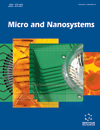- Home
- A-Z Publications
- Micro and Nanosystems
- Previous Issues
- Volume 15, Issue 4, 2023
Micro and Nanosystems - Volume 15, Issue 4, 2023
Volume 15, Issue 4, 2023
-
-
Amoxicillin-loaded Nanotechnological Carriers for the Effective Treatment of Helicobacter pylori Infection
More LessAuthors: Darsh Gautam, Poonam Talwan, Sahil Dhiman, Rahul Gill, Aparna Thakur, Simran Dhiman, Deexa Sharma, Akhil Kumar and Saksham SharmaBackground: The bacterium Helicobacter pylori (H. pylori) is known to cause gastroduodenal disorders associated with the stomach lining that grows in the gastrointestinal tract, and can cause gastritis, peptic ulcer, gastric lymphoma, and stomach cancer. Nearly 50% of people worldwide suffer from H. pylori infection. This infection is more prominent in poor nations and undeveloped countries, and is caused by multiple fac Read More
-
-
-
Activation Energy Rechargeable Prussian Yellow Nano Film Electrode using Hydrated Ions
More LessAuthors: Abeer Baioun and Hassan KellawiAim: Interfacial charge transfer is a fundamental issue in both the science and technology of the batteries. In this work, the activation energy for the interfacial charge transfer, Ea, though PY thin film was estimated by measurement measurements of electrochemical impedance spectroscopy (EIS) for both monovalent and multivalent hydration cations: Li+, Na+, K+, Ca+2 and Mg+2 in aqueous electrolytes.Background: Rechar Read More
-
-
-
Impact of Gaussian Traps on the Characteristics of L-shaped Tunnel Field-effect Transistor
More LessAuthors: Sweta Chander, Sanjeet K. Sinha and Rekha ChaudharyBackground: Internet of Things (IoT) applications require high-performance TFET devices that can be efficiently integrated with the cyber world and physical world.Objectives: The impact of introducing Gaussian traps in hetero-junction tunneling-field-effecttransistors (TFET) with an L-shaped gate is presented.Methods: The 2-D TCAD study of different characteristics, like input, output characteristics, and noise spectral density with t Read More
-
-
-
A Problem-solving Bionic Design Methodology for Structural Applications (BREED)
More LessAuthors: Gururaj Fattepur, Rohith Vaidyanathan, Ravi C. Guttal and Matthias RädleBackground: Nature-inspired designs, which have evolved from proven strategies of nature, have been a constant source of inspiration for designers and engineers to solve real-life problems.Methods: Current bionic design methods are theoretical and are discordant with the design engineering workflow. A proposed methodology suggests suitable bionic forms for a given design space. This procedure consists of the f Read More
-
-
-
Effects of the Impacting Velocity and Angle on the Grinding Force, Force Ratio and Deformation Behavior During High-shear and Low-pressure Grinding
More LessAuthors: Guoyu Zhang, Yebing Tian, Sohini Chowdhury, Jinling Wang, Bing Liu, Jinguo Han and Zenghua FanBackground: The normal grinding force is generally larger than the tangential one during conventional grinding processes. Consequently, several machining issues arise, such as a low material removal rate, a high grinding temperature, and poor surface integrity. To overcome the constraints associated with conventional grinding methods, a novel "high-shear and low-pressure" flexible grinding wheel is utilized. A thorough inve Read More
-
-
-
Preparation, Characterization, and Release Profile Study of Vincristine Sulfate-loaded Polycaprolactone Nanoparticles
More LessAuthors: Walaa Fawaz, Jameela Hasian and Ibrahim AlghoraibiBackground: Vincristine sulfate is commonly used to treat different types of cancers. However, its effectiveness is hindered by undesirable side effects, which significantly limit its applications in medicine.Objective: This study aims to prepare vincristine nanoparticles, in order to develop a promising approach for cancer therapy.Methods: Vincristine nanoparticles were prepared by utilizing polycaprolactone as a carrier throu Read More
-
-
-
Universal and Reversible Gate Design in Quantum-dot Cellular Automata Nanotechnology
More LessAuthors: Vijay K. Sharma and Sadat RiyazBackground: Growing progress in the field of nanoelectronics necessitates ever more advanced nanotechnology due to the continued scaling of conventional devices. For the purpose of fabricating current integrated circuits (ICs), Quantum-dot cellular automata (QCA) nanotechnology is the most suitable substitute for complementary metal oxide semiconductor (CMOS) technology. The problem of short-channel secondary eff Read More
-
Most Read This Month
Article
content/journals/mns
Journal
10
5
false
en


